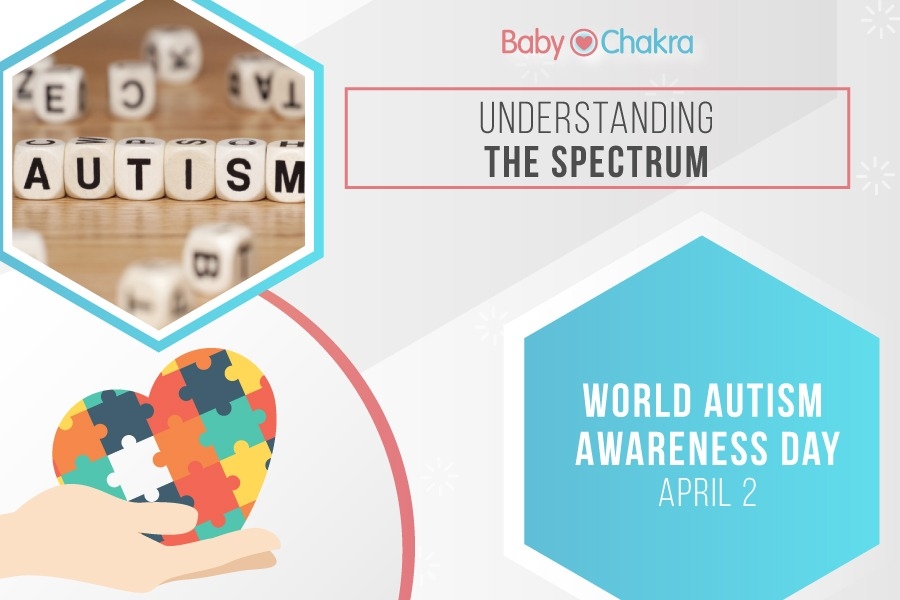
Busting Myths Around Autism
29 Mar 2018 | 4 min Read
Dr. Manjiri
Author | 1 Articles
Autism is a developmental disorder. Current statistics report one in 68 children suffer from Autism Spectrum Disorder. It emerges in the first three years of life. It is much more common (4 times) in boys than in girls. It causes delay in basic areas of development like speech and language and social interaction.
The most obvious signs of autism may appear between 2 and 3 years of age. In some cases, it can be diagnosed as early as 18 months.
Some of the early signs of autism you could watch out for as a parent are:
By 6 months: No smiling, no joyful expressions
By 9 months: No back and forth sharing of sounds, smiles and other facial expressions
By 12 months: Not responding to name call, no babbling/pointing/showing/reaching out
By 16 months: No spoken meaningful words
By 24 months: No meaningful two word phrases
Signs in older children:
- Appears disinterested in people around
- Does not like to be touch/ cuddled
- Does not engage in pretend play (Ex: drinking from toy cup etc)
- Lacks imitation skills
- Does not understand non verbal communication (facial expressions, tone of voice or gestures)
- Repeats same phrase/ word
- Lacks meaningful speech
- Does not follow simple instructions
- Does not give eye contact
- Reacts unusually to sight/smell/texture and sounds
- Has difficulty adapting to change in routine
- Unusual attachment to particular toys
- Spends long time watching moving object ex wheels of car/ fan
- Repeats same action ex: flapping hands, rocking, twirling ( stimming behaviour)
How is autism diagnosed?
Following steps help in establishing diagnosis of autism:
- A thorough evaluation comprising a detailed history, observation, developmental history taken usually by a child psychiatrist/ developmental pediatrician
- Psychological evaluation by a child psychologist. Comprises of psychological tests like IQ assessment and other tests
- Occupational therapy assessment by an occupational therapist
- Speech and language assessment by speech therapist
- EEG/ Brain scans- only in suspected cases of neurological disorders
- Hearing test in cases of speech delay with suspected hearing impairment
What can parents do if they see these signs in their child?
Do not follow the ” Wait and see approach”. Talk to your child’s Pediatrician immediately and express your concerns. Your Pediatrician will refer you to a Child Psychiatrist. A complete psychological evaluation along with an occupational and speech therapy assessment is needed following which various therapies can be initiated. The earlier the therapies are initiated, the better is the outcome.
Treatment is a multimodal approach. The treating team must include a child psychiatrist, child psychologist, behavioral therapist, speech and language therapist, occupational therapist and a special educator.
Parental involvement in therapy is of utmost importance.
There are no medications to cure Autism. However, medication may be used for comorbidities like ADHD (Attention deficit hyperactivity disorder), seizures and behavioral problems like aggression.
There are many myths around autism. Let us take a look at the actual facts and dispel myths:



Myth: Autism is caused by vaccines.
Fact: It has been proven that autism is not caused by any vaccine.
Myth: All children with autism have savant/extraordinary skills
Fact: While some children with autism can have some savant skills, eg: photographic memory/ quick with numbers etc, it is not that all of them have such skills. These are, in fact, quite rare.


Myth: Autism is a boy’s condition
Fact: Autism is four times more common in boys than girls. However, it does affect girls too.
Myth: Autism is the childhood form of schizophrenia
Fact: No, they are two entirely different conditions. The two conditions have different causes and different symptoms.

Myth: Autism affects only a certain class of people
Fact: Autism may be seen in people of all levels of socioeconomic status and across all cultures.

This World Autism Awareness Day, let us all pledge to understand the condition better and speak up against the stigma.
Also read: They Need Empathy, Not Sympathy
Explore the entire collection of articles: Special Needs
A


Related Topics for you
Suggestions offered by doctors on BabyChakra are of advisory nature i.e., for educational and informational purposes only. Content posted on, created for, or compiled by BabyChakra is not intended or designed to replace your doctor's independent judgment about any symptom, condition, or the appropriateness or risks of a procedure or treatment for a given person.
